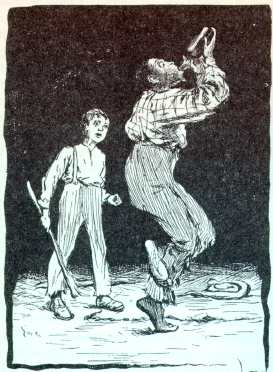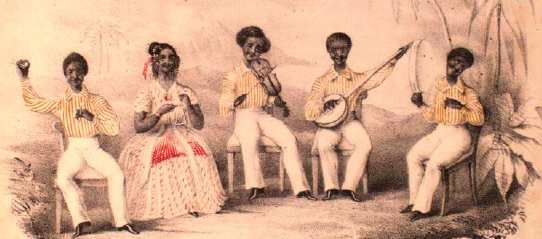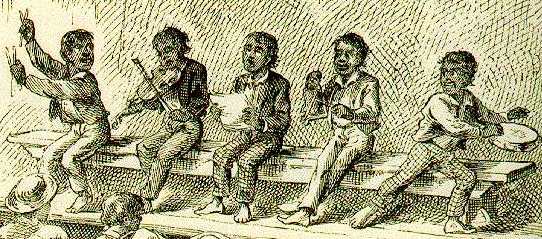| Bones in Love | ||
Blackface Minstrelsy
and made a sensation." — The Adventures of Tom Sawyer
The very first minstrel show probably occurred in 1843, in New York City. Within a year it became the most popular form of live entertainment in America, and it remained so from the time Tom Sawyer was a child up to the time MT began writing Huck Finn. It's known that MT loved the form — in an autobiographical reminiscence dictated in 1906 he refers to "the genuine nigger show, the extravagant nigger show" as "the show which to me had no peer" and "a thoroughly delightful thing." But beyond that commentators disagree on how to characterize the minstrel show as a source for the novel.
In the minstrel show white entertainers put on blackface and "imitated" or "caricatured" slaves in the South and ex-slaves in the North. The distinction is crucial. During MT's times most white commentary on minstrelsy (including MT's own remarks for his autobiography) assume its accuracy, its essentially faithful imitation of African-American speech, singing and dancing. Since the Civil Rights Movement, on the other hand, nearly every commentator agrees that the minstrel show "coon" is a racist caricature.The group pictured below, Harmoneons Carolina Minstrels, is atypical in its inclusion of a woman, but this picture, from the cover of a piece of sheet music published in 1845, is the earliest illustration of minstrelsy in the Barrett Collection:
In Tom Sawyer minstrelsy appears in both the text and the illustrations. After the company that visits St. Petersburg finishes its run, Tom and Joe Harper get up their own troupe and are, as the caption for the following True Williams illustration puts it, "happy for two days":
The minstrel show is one kind of entertainment that the King and Duke don't attempt in Huck Finn. The question remains, however, whether in some sense MT is enacting a version of minstrelsy in the novel as a whole, with Jim cast in the role of the "minstrel darky." Would contemporary readers have heard Huck's conversations with Jim as simply a written version of the familiar "Ethopian dialogues" between Mr. Interlocutor and the minstrel show's end men, Bones and Tambo?
 [Description: Kemble's illustration of
Huck watching as Jim dances]
[Description: Kemble's illustration of
Huck watching as Jim dances]
How familiar MT's contemporary white audience would have been with the stereotypes of minstrelsy is indicated by the many notices and ads for minstrel performances that I found while looking for reviews of MT's early lectures in newspapers from Cleveland or Peoria or Newark. It's also clear to me that Cort, the white New York teenager Edward Kemble used as his model for the figures in his illustrations for Huck Finn, imagined African-Americans after the model of Bones and Tambo. Kemble says Cort most enjoyed posing as Jim: "he would jam his little black wool cap over his head, shoot out his lips and mumble coon talk." And when I look at Kemble's representations of Jim, I don't see a human being, but this same caricature.
MT's contemporary white readers would have seen nothing wrong with a "minstrel-show" version of an African-American. But the question of what kind of "source" minstrelsy was for MT's novel remains unanswered by a reference to the racist prejudices of his popular audience. Does MT's representation of Jim reinforce or complicate or subvert such prejudices?
One way to answer such questions is to compare the kinds of routines that audiences heard at the minstrel show with the kinds of conversations MT stages between Jim and Huck. Immediately below is a typical "Ethiopian dialogue," taken from a 19th-century text called Minstrel Gags and End Men's Hand-Book (New York: n.d., Dick & Fitzgerald, Publishers). It is followed by links to two passages in Huck Finn, where it seems to me that in Huck's lines one hears the correct accents of Mr. Interlocutor, and in Jim's replies, the comic inadequacies of Mr. Bones.
| Bones in Love | ||

